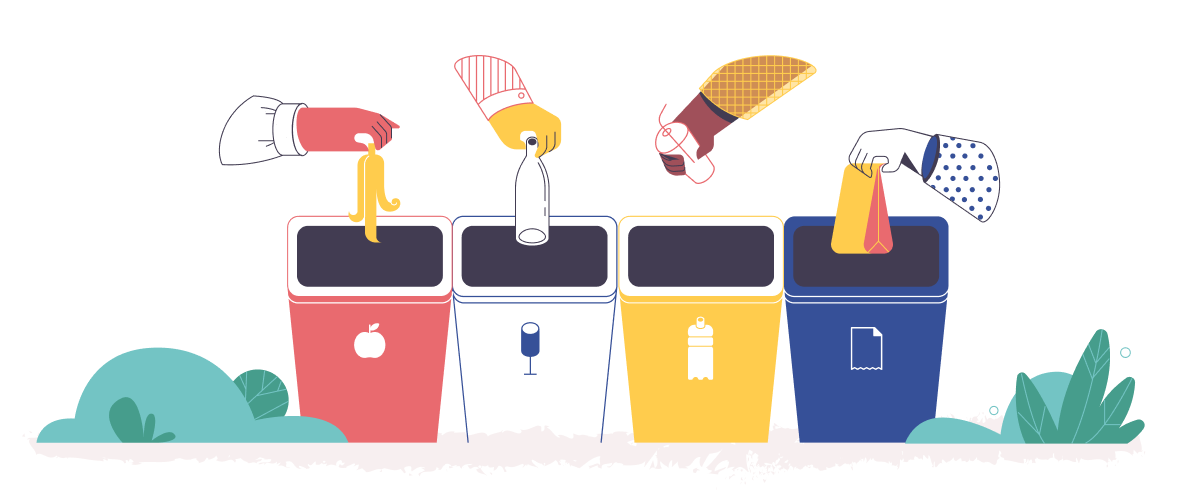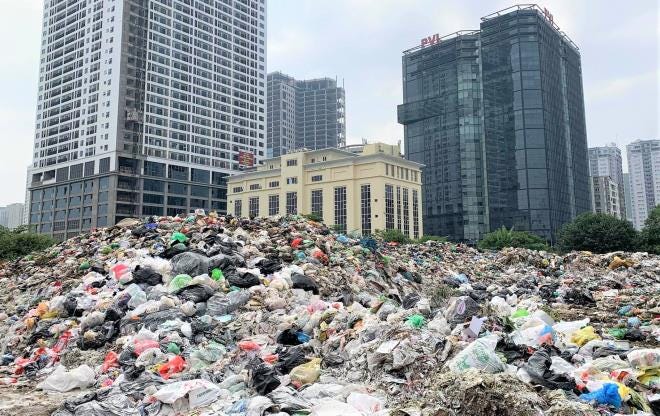

UX Research for simple waste segregation in Hanoi
source link: https://uxplanet.org/ux-research-for-simple-waste-sorting-in-hanoi-6efdee4790d8
Go to the source link to view the article. You can view the picture content, updated content and better typesetting reading experience. If the link is broken, please click the button below to view the snapshot at that time.
UX Research for simple waste segregation in Hanoi
How UX can prevent Hanoi’s urban area from being flooded with garbage.


Context
According to GSO VN’s data, urban households in Hanoi’s 12 districts disposed of more than 6500 tons of domestic waste daily. It is estimated that by 2030, this figure will reach 12,000 tons per day, which may cause a crisis in the Capital’s waste management system.


To solve this problem, World Bank Vietnam has suggested multiple programs on waste sorting by urban households, which can be converted into clean energy or recycled for various purposes. It is hoped not only as a sensible option to lessen the burden of the government’s waste treatment but also to impact our environment positively.
Small action, big impact
As a challenge, we — TeamGreen, were tasked to find an answer to solve this problem by UX Research skillset. If UX Research can improve citizens’ waste disposal behavior in Hanoi’s urban areas, how and where should we begin?
The approach
The first step was to define the methodology that was going to be used for the next two weeks so that everyone in the team would pull together in the same direction. In particular, we built a basic research process, including four steps: Planning, Desk Research, Contextual observation — Interview, and Finding Solutions.

Research Methodologies
With a top-down analysis method, TeamGreen has started identifying a “big picture” about Hanoi’s waste condition, then broke it down into comprehensive factors to discover the root cause of this condition:
- An object of study: urban households in Hanoi.
- Characteristics and related aspects of domestic waste.
- Operation of the domestic waste management system in Hanoi.
- Current waste-disposal behavior of Hanoi urban citizens.
- What is the our goal, and how to reach it?

Desk Research
The desk research method provided us several benefits such as cost-cutting, time-saving, and obtaining domain knowledge effectively. Using existing data, we have gained general information about urban households, waste terminologies, and the city’s waste treatment system.
The result seems to open up a new horizon for all members of the research team. It is a stepping stone for the direction of the solution we aim for in the future. However, after weeks of analyzing data, we decided to narrow our scope to focus on a target that could represent the city:
- Residents in Dong Da district.
- Single-family home.
- Households have someone cooking.
- High-income family (based on Vietnamese average income)

Our statistical report can be found here.
After weeks the desk research, we will have to explore urban citizen residents for a better picture and how to improve their behavior.
Contextual Observation
Dongda district is one of the most densely-populated districts in Hanoi, with over 42,422 persons per kilometer. Waste treatment behavior takes place on every corner of the street. When conducting a field observation, the team has discovered the following key insights:
- A specified person in the household has a duty to put waste away everyday.
- Plastic bags(shopping) put out domestic waste.
- Waste is usually discarded in front of the house-door, along the street, or at the alley’s entry, laying and waiting for waste collectors.
- If there is a large amount of food waste, residents will put them in a small plastic bag, put it in a trash bin, or even put everything in a big plastic bag.
- Urban citizen has already formed a habit of dumpling trash everywhere.
Interview
Along with contextual observations are interviews and direct dialogues. Our target is residents of Dong Da district, in the age group between 25 and 40. Two main personas are summarized from the interview:
- The Ignorance — The person who doesn’t care about the fact that poor waste disposal is detrimental to our environment and deteriorates ecosystems. They also have no awareness of waste separation.
- The Sorter — The person who really concerns waste separation and has done the sorting before.

Once more, the main conclusion was that two groups had very similar perspectives.
- Residents pay a little attention to proper waste treatment instructions.
- Residents dislike waste left in their homes and consider maintaining a clean street as a sanitation worker’s job.
- Residents rarely speak out when they witness their neighbors dumping trash illegally, though they are aware of this misbehavior being against the laws.


Besides, 2 groups also share some same pain points:
- Sorting protocol is hard to memorized and it makes people feel unmotivated.
- Waste sorting is time-consuming.
- The cleaning process is complicated.
- Recyclable waste occupies a lot of space, especially plastic bottles.
- Residents are not guided how to separate waste correctly.
After analyzed interviews result, we have visualized the waste disposal journey in a typical household with Empathy Map & Customer Journey Map.
At this point, our tasks were clear: Improving waste sorting experience with modern psychology theory.
Solution
According to the research, TeamGreen came to brain-storming weeks to find the possible solutions. Since Vietnamese always show their interest in social interaction and their community, we can start with some community solutions.
To create or improving behaviors, we had applied Reinforcement Theory of Motivation — by B. F. Skinner
Reinforcement Theory of Motivation
Base on the theory, here are some simple solutions for existing pain points:
- To save people time and space, we should: improve their experience by using a multi-compartment sorting bin.
- To stop people from throwing everywhere, we should not use un-effective signs. We can help people find other places to throw or use illustrations or planting trees.
- Increasing the penalty fee is effective at this time. However, the longer it takes, the more people will definitely find another way to pass the law.

Color Sorting bags
This method has been proven to be successful in Seoul, South Korea. The city government slowly educated people to memorize what kind of bag accepted food waste. Soon, they will continue with other types. According to their success, we did some research and modified it to make it fit Hanoian.
First, we will focus on redesign the bags and the bin:
- Sorting: Green for fresh, yellow for recyclable, and red for a plastic one. The supermarket’s storing bag will also come with an instruction paper to educate people on how to sort.
- Trash-can: Public trash-can will have with impactful & easy-to-understand instruction design.

Since Vietnamese has a habit to reused food-storing bag as a waste bag, the important point is how we can control their sources. Luckily, in most of the parts in Hanoi, poly bags come from the marketplace or supermarket. That actually makes it easier for the district to control which bag and how the seller will use it.
In crowded neighbor, this maybe is the best way to improve UX of the sorting behavior for all ages.
Digital Solutions
Through the research, TeamGreen has contacted many environmental NGOs and professionals.
They had shared with us many structures & solutions based on their experiences. Moreover, thank to them, we defined many problem that are too complicated to solve.
However, once they had shown us their digital solution, we carried out where we could check how the UX can be improved with our knowledge.

The point is that they should focus on educating and hooking The Sorter group into their app. We have applied some Hook-model theory to define what “gamification” can do with their app.
- Based on our interviews and research, The Sorter group do not see their action can impact anything — that is why most of them gave up after the first time trying to sort the waste.
- In other ways, the vouchers — which the apps used to hook their users — do not really attract them. It turns out; people nowadays feel justified if their activities impact the environment.
- The gamification helps us hook the users, but they can also get more users by sharing social media. Once finished this feature, TeamGreen has also helped them redesign other screens. But it will be another story in another post.
Conclusion
Through this project, TeemGreen has learned many things. We know this topic will need more time and effort to archive something, but we really hope this research can help others share the same vision with us to faster their work.
However, this research is still on the paper, no matter how beautiful the painting we draw, the most realistic and finest solution right now is: Reduce.
In the end, a life is made up of the things we have done, not the things we have bought. Buy less, choose wise, save the planet.
TeamGreen:
Anh Quan — UX Designer
Minh Tam — Researcher
Alex Hoang — UX Research Mentor
Recommend
About Joyk
Aggregate valuable and interesting links.
Joyk means Joy of geeK